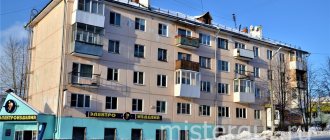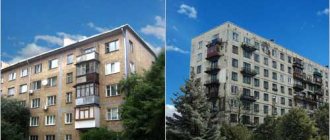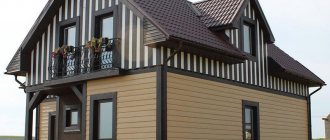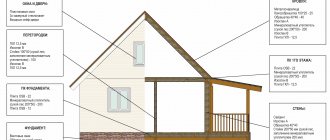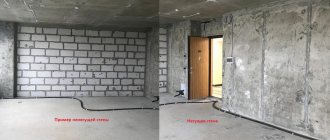The height of a 10-story building in meters is a variable parameter that depends on the series or individual project, the main material used for construction, design features and even climatic conditions.
In different cases, the height of 10 floors is 33–40 meters, but these data are indicated only in relation to the above-ground part of the building. In determining the exact data, the exact height of the floor is certainly taken into account (it can vary from 2.5 to 3.3 m), as well as the presence of an attic or additional structures. Data on the height in meters of a specific building can be obtained from special institutions.
Classification of number of storeys of buildings
The following classification of residential buildings is distinguished, which differ in the number of floors:
- Low-rise (1 - 3). Most often these include individual residential buildings. The height of the building, as a rule, does not exceed 12 meters;
- Mid-rise (3-5). The height of the floors is 15 meters - this is a standard five-story building;
- High number of storeys (6-10). The building is 30 meters high;
- Multi-storey (10 - 25):
a) Category I - up to 50 meters. Buildings with a maximum level of 17-18 floors;
c) Category II - up to 75 meters. The height of a 15-storey building is approximately 55 meters;
c) Category III - up to 100 meters. Such buildings have a maximum of about 25 floors.
- High-rise. From (25 - 30).
The number of storeys of a building is calculated solely by the number of above-ground floors. When calculating the number of storeys, not only the size from floor to ceiling is taken into account, but also the size of inter-floor ceilings.
How is the exact height of a multi-story building determined?
The exact height of a 10-story building is determined on the basis of the project, which became the fundamental document for its construction. During the times of state standardization, the design of the series was carried out taking into account the building material used.
The construction of a panel house was designed to produce panels of certain parameters, the construction of a brick house was designed to produce products from brick factories in areas where there was no point in building large house-building enterprises.
A general, abstract, approximate answer to the question of how many meters high is a 10-story building may also contain discrepancies. For example, an approximate floor height defined as 3 m (including a standard flight of stairs) gives a figure of 30 m, which almost never corresponds to reality.
The height of a ten-story building in more accurate calculations requires taking into account several circumstances at once:
- The height of the ceilings, which in different series can vary from 2.64 to 3 m. In series 97 of the Brezhnev period, it is indicated in meters in exactly this range. It all depends on the region of construction and the number of floors in a large-panel house.
- Roof type. In the same 97 series, a flat, roll-free type was mainly used, but sometimes the project included a technical floor, an attic attic, and a roof with a slight slope. And this also plays a role in determining how many meters the vertical parameter will be.
- In addition to the precisely known height of the ceilings (the so-called interfloor space), the height of the interfloor ceilings is taken into account - a durable layer separating one floor from another.
It is necessary to take into account
The total height of a ten-story building is not only its residential part, but also:
- basement;
- ground floor;
- attic.
You can succumb to temptation and follow stereotypical calculations, which are usually given in incompetent sources. For example, take it for granted that a 5-story building is 15 meters high, and calculate the dimensions of a 10-story building as two five-story buildings stacked on top of each other. However, if there is a need for reliable data, such calculations are unacceptable.
You can find out what the height of a particular house is only if you have official documents - a description of the series or a modern special project.
The latter is important, since new construction technologies, using monolithic concrete and excluding standard panel construction parts, allow ceiling heights of 3 meters or more.
Features of house construction
Expediency in spending funds and centralized construction management were the means to overcome the housing crisis. The maximum economy mode involved not only eliminating parts that were not essential, but also ensuring the safety of residents without additional elements.
In the Soviet Union, nine-story buildings were built en masse because a fire truck ladder was enough to reach their height (27–30 m). Consequently, emergency exits and passages were not required in case of danger.
Such structures did not require alternative methods of removing residents from a fire building. The length of the fire escape is 28 meters, and it is quite enough to evacuate people from a building 30 meters high.
The construction of a 10-story building already requires the equipment of a technical floor in accordance with current building and fire safety standards. If not for this circumstance, a ten-story residential building could be 30 meters high, but its conditional parameters in reference books start from 33 m and officially end at 40 meters.
But this data still does not include office buildings built with higher ceilings. Also, special projects where the layout differs from the standard ones are not taken into account. The situation is reminiscent of the difference in height between Khrushchev and Brezhnev - a house built from panel structures or a brick one.
In Moscow, the first house with 10 floors was built by the architect Nirnzee in 1913, and its height was 40 meters. It was truly a unique building. We can say that Moscow has always been a pioneer in such risky projects.
However, the construction of the 97 series and other standard projects with 10 floors was much less widespread in Moscow than in Altai, the Krasnoyarsk Territory, the Kemerovo and Novosibirsk regions, and the Sverdlovsk and Arkhangelsk regions of residence. Until 2010, ten-story houses in the series could have ceilings from 2.64 to 3 m. They were built by local ZKPD and DSK and contained some features.
How to determine the height of a house
The need to obtain data to satisfy a banal interest can be done in the simplest way - by multiplying by 3 the number of floors and an allowance of 3 meters for technical equipment. This is how the first digit of the official data is obtained.
Multiplying the number of storeys by the ceiling height in meters is also not very informative. After all, there are ceilings between floors, an attic, a basement, options with a raised base and a technical floor. The type of roof used also matters.
The most informative thing in modern development conditions is a trip to a departmental organization. It is there that you can find not only information about the type of project to which the building with the apartment belongs, but also what the exact height of the 10-story building of this particular series is.
A special need may arise when selling your own home, since you will need to provide information to a realtor or a future buyer. You can also find the structure index and see its standardization by series on special information portals.
Apartment buildings. Number of floors and height of buildings
In modern projects, the “golden mean” is considered to be a height of one floor of 2.8-3.3 m.
The construction of multi-storey buildings is carried out only by highly qualified specialists, since this business not only requires large expenses, but also has many nuances.
The following types of multi-storey buildings are distinguished:
- Panel. Belongs to the budget series. It has a high construction speed, but poor heat and sound insulation. The maximum number of storeys is about 25, depending on the design. In a living room, the height from floor to ceiling is 2.5 - 2.8 m, depending on the size of the panels.
- Brick. The construction speed is quite low, since construction requires high costs. Thermal and sound insulation indicators are much higher than panel ones. The optimal possible number of floors is 10. The height of each is on average 2.8 - 3 m.
- Monolithic. These buildings are quite diverse, because everything depends on the load-bearing capacity of concrete. They have high seismic resistance. To improve heat and sound insulation during construction, brickwork can be used. Allows the construction of about 160 floors. Height from floor to ceiling 3 - 3.3 m.
Typical buildings of the USSR
Typical panel and brick 5-story houses began to be actively built during the times of Khrushchev, starting in 1957. The country needed cheap housing and as quickly as possible. That is why such projects were developed, some intended for the southern regions, others for the northern. The brick ones had a slightly better layout and room sizes.
The same serial project, built in different regions, could be slightly different. Different climatic conditions and the soils on which the construction was carried out made their own adjustments to the size of the five-story buildings. It is clear that each project differed in the height of the building.
Type series K7
Type series II-14
Type series II-05
Type Series 1605-AM-5
Type series 1-335
The length of a 5-story building with 4 entrances for a typical 5-story building of project 1-528-3k is 72.4 meters. It depended on the layout of the apartments and slightly on the thickness of the panels. The wall thickness of the panels ranges from 300 mm to 400 mm.
The length of the five-story building with 4 entrances is 72.4 meters
“Brezhnevki” were built until the end of 1980, and successful projects are being taken as a basis even now. They were not particularly different from the “Khrushchev” apartments, but the entrance area was larger, the flights of stairs were wider and a garbage chute was installed.
How to obtain permission for individual housing construction? What does a developer need to know?
Limiting authorities follow the development procedure and approve documents for individual housing construction according to RSN 70-88. Thanks to them, not only the accuracy of site development is determined, but also the layout of the home and auxiliary buildings. This project needs to be carefully considered, because what is not shown in the plan will be recognized as an unauthorized structure and must be demolished or re-approved.
Without permission, that is, before the plan is approved and documents are received, work should not begin, otherwise serious problems may arise. In order to find out exactly what documents will be required to start construction, you should read the “Code of Rules for Design and Construction SP 11-III-99”.
In 2010, SNiPs were recognized as sets of mandatory rules. They regulate activities in the field of urban planning, as well as engineering work, design and construction.
In order to obtain permission, you need to contact the BTI or the city architectural department to provide:
- application for planning permission;
- documents establishing the right to use the site;
- certificate of field determination of boundaries, placement of buildings, etc.;
- cadastral plan of the site;
- House project.
Once issued, the permit is valid for 10 years.
Characteristics of brick, large-block and panel “Khrushchev” buildings
Khrushchev buildings were built according to standard designs in the style of functionalism. Nothing extra. They were panel, brick, and less often large-block. As a result, the most famous were the Khrushchev panel buildings. Because they were quickly built from pre-prepared reinforced concrete panels.
The speed of construction of “Khrushchev” buildings was very high, so the quality of the houses often suffered because of this. In addition, these houses had low thermal insulation of external walls and poor sound insulation inside the house.
Typically, the height of most “Khrushchev” buildings was 4 or 5 floors. Because the height of a five-story building is the maximum height where building codes do not require an elevator. As a result, the 5-story format replaced the 4-story format due to the opportunity to build more apartments.
“Khrushchev buildings” could have 2 or 3 floors. These were more common in rural areas or small towns. Some series of Khrushchev buildings even had a garbage chute. Of course, the height of the house directly depended on the height of the ceiling.
Large block "Khrushchev".
Savings in the economy
During the Soviet era, much was standardized. Standards appeared based on standards, which were determined by calculations and tests. At the same time, projects for different regions differed. Soil and climatic conditions were taken into account and, most importantly, to build as economically as possible. The main task during the USSR was to provide people with housing, and convenience and comfort were in the background.
Savings explained a lot. The priority in the construction of 5 and 9-story buildings erected at that time is explained by simple reasons. A house with a height of more than 28 m had to be equipped with smoke-free stairs with a passage through an open balcony. Due to compliance with fire safety regulations, the installation of gas stoves is allowed only up to the 9th floor.
And besides, in addition to the elevator, which should have been equipped with nine-story buildings, as opposed to 5, 10-story buildings and above, they should have had a freight elevator. The cost of housing in such houses increases greatly and only pays off when constructing buildings of more than 14 floors.
Another reason for the popularity of the construction of 9-story buildings is that fire engines had standard stairs with a reach of up to 30 m. At that time, they used imported mechanized stairs “Magirus” or “Metz” installed on ZIS-6 (PEL-30).
30-meter ladder on a ZiS-6 chassis
Foundation and roof
The height is 27 meters lower than the real one, the reason is due to unaccounted values. The house is not built directly from the ground, it stands on a foundation that has some elevation from the ground level. Residential floors come after the basement. The ground floor of a house is a room that is partially located in the ground; in high-rise buildings it is usually a basement.
Entrance to the ground floor
The foundation is quite a massive structure and must withstand the weight of 9 floors, which can be 15–18 thousand tons (one entrance). But it is almost all hidden underground and is not taken into account.
Roof, complex technical structure
This is another plus meter to the resulting result, in total it is already 28 meters. A technical floor or roof can be added to this result, approximately 2.0 meters. In some buildings, instead of a technical floor, the elevator lifting mechanism was installed on the roof, and then the height of its cut will be indicated on the project.
Home to live
It is correct to approach the determination of the size of a house from the standpoint of reasonable sufficiency, but there must be enough space for a comfortable stay for all permanent family members.
Initially, the required number of isolated rooms for different purposes (kitchen, bathroom, living room, etc.) is determined. In private houses, it is advisable to provide a vestibule. In the cold season, a vestibule with a door prevents unnecessary heat loss.
Even a small vestibule will save heat in winter Source pinterest.ca
Square
The next stage is determining the area of each room. First, you can plan the desired area, and then, based on practical and economic reasons, reduce the size to reasonable limits. At the same time, try to realistically imagine the room and what furniture will need to be installed in it.
Rational operation is ensured by a fairly economical area; based on the data presented, standard house designs have been developed:
- hallway - at least 5 m2, provide space for a closet;
- living room – from 20 to 30 m2, windows facing south, west;
- kitchen – 10-16 m2, provides comfortable accommodation for all family members;
- bedroom for one person – 10-12 m2, for two – at least 14 m2;
- bathroom – no more than 10 m2.
The kitchen should comfortably accommodate the whole family Source houzz.com
The height of the walls is at least 2.5 m. Square-shaped rooms are easy to furnish and create coziness.
For a family consisting of parents and 2 children of different sexes, it is enough to build a house of 80 m2 . If you want to have an office, to get larger rooms you will need an area of 100 m2 or a little more.
The number and area of rooms, as well as the location of windows relative to the cardinal directions (for example, to the south or north) affect the operation of heating and air conditioning systems, which in turn determine the volume of gas and electricity consumption and, accordingly, the amount of payment for them. The rule is that the larger the area of the house, the higher the cost of utility bills.
Classification of houses by number of levels
First, let's look at what height houses exist:
- low-rise – buildings whose height does not exceed 12 meters, or 3 floors;
- mid-rise - the distance from the floor of the first floor to the roof reaches 15 meters, or 5 tiers;
- high – up to 10 floors and a height of up to 30 meters;
- multi-storey – up to 100 meters high (up to 25 levels). This category is divided into a number of subcategories I (up to 15 floors), II (up to 20), and III (up to 25) types.
- high-rise – minimum number of storeys from 25 and height from 100 meters.
The choice of materials for the “high-rise building” also depends on how many floors are planned to be built.
Myths and reality. Part 2. Number of storeys.
Hello!
Let's continue our study of building a modern and comfortable home. Let us remind you that we have divided this topic into 3 parts:
- House area
- Number of floors of the house
- House layout
- What is the difference between a house and an apartment?
For those who have not read part 1, we recommend starting with it , this is the basis. Planning the number of floors without understanding what the real need for space is is at least strange... Just don’t say that you want “only 2 floors” - it doesn’t happen =)). Maybe you just want a ladder, but that's a completely different story.
So, part 2: Number of floors of the house.
Let's start with an easier question, because future home owners have finally begun to make a rational decision on it.
Question 1.
Is a basement really necessary?
There are situations when this is really justified. For example, this may be due to the complex terrain of the site or the impossibility of installing the necessary additional premises on the 1st floor level (possibly a very small area).
Our experience and people’s reviews confirm that the ground floor in most cases is:
- Just burying a serious amount of money in the ground - from half a million rubles and above. Do not think that by “increasing” the height of the foundation a little you will get an additional floor; in the end the price will be much more expensive and the benefits will be questionable.
- Significant areas with vague and, moreover, often unnecessary functionality, which still require cleaning, heating and repairs.
Let's consider several basic scenarios for what to use the basement for:
- I'll make a garage in the basement.
To make a garage in the basement you will need to make a ramp of significant length. To be more specific, the length of this ramp will be about 10 m, despite the fact that the garage will be recessed by 2 meters (the height of the Cruiser 200 is 1.95 m). You may ask why the ramp is so long? Do you think 5 meters is enough? Not enough, unless, of course, you drive a Niva - a short one)).
This length is due to two things: slope and fracture.
The slope, even with a 10-meter ramp, will be far from small 11 degrees. For understanding, I will say that most modern sedans can easily drive into a corner of only 10-15 degrees.
Steeper - it will rest against the bumper or hang on the “belly” at the turn of the exit
That is, in addition to the cost of your foundation, prepare money for 2 retaining walls, each 10 meters long, and a monolithic floor, which will be possibly larger in area than the area of the garage itself.
Price:
To do this, you will need about 20 FBS blocks 2.4 m long and 30 cm thick. The cost of the block is about 1,500 rubles. with delivery. Plus pour a concrete ramp. You will spend at least 40-50 thousand rubles on materials alone. And if you count the work of an excavator, a crane, backfill from ASG, mortar, and territory planning. This amount can be safely doubled.
The second necessary thing is a canopy. Without it, this structure is not only unsuitable for use, but also dangerous - both for the car (driving or driving on an icy surface is unlikely to be a pleasure for you) and for the house - water from precipitation will go straight under the foundation. The price of the canopy...well, at least 40 thousand.
Here's a garage in the basement - another plus 150 thousand rubles. More precisely, this is not a garage - it is literally only an entrance ticket to it))
- In the basement I will make a cellar for food.
You won't. Even if it is not heated, it will always be very warm there. 10 degrees exactly. Only because there is always a warm positive temperature above it.
Review from a real person from one specialized website: “You won’t get a full-fledged cellar in the basement. At least I haven't succeeded yet. There are two main problems; I’ll cover them one by one:
- Lack of natural humidity. My basement floor is at a level of 3m. The slab is cast on the ground. The walls are brick, external insulation is 6cm EPS. High-quality waterproofing has been made on the floor and walls. As a positive result, the basement is very dry. As a negative, vegetables are not stored at all. Potatoes, carrots, beets - a bag dries out within a week to an unmarketable, wrinkled state. Cabbage is more or less holding up, onions, garlic are all excellent.
- Despite the high-quality thermal insulation (10cm min of cotton wool on the ceiling, a reinforced concrete slab above, then heated floors on the first floor), there is still a lot of extra parasitic temperature in the “pantry” room. True, I blame the boiler room (gas boiler, boiler and pipes) located behind the wall in the next room. But the fact remains that I cannot lower the temperature below 12-14 degrees Celsius. True, this is enough to store most household items - some have been standing for 3 years, and nothing happens to them. So for now I store potatoes, carrots and beets in a separate cellar under the garage.
- In the basement I will put a boiler and other technical rooms.
Perhaps the closest application to life. This even has its advantages - the boiler is located at the bottom, that is, you can make a tray in the wall and easily supply fuel, as well as “correct” circulation of the coolant, possibly even without a pump. Is it worth building a basement under the whole house for this? Hardly. For the boiler room and technical rooms you need 10-20 square meters.
Maybe you just need a competent project on how to fit them in without installing a base?
Question 2.
How many floors do you need?
Previously, people built 3 floors, or 2 plus a basement, now more often just 2 floors.
Almost no one has the question of building a one-story house. What usually happens is: the customer says I just want 2 floors and that’s it. Not even discussed. But there is something to discuss)). Even if you are sure that you also only need 2 floors, read it, perhaps you will learn useful things for yourself.
Why do I want a two-story house?
- This is rational, since I get 2 times more rooms on the same building area. Especially if the area is small.
The building area is really shrinking. The question is, what will you choose to live in your own home: a comfortable house (forgive the tautology) and a rational layout of the site or a vegetable garden-plantation with a 2-story house? But we don’t go to extremes: if you have a plot of 6 acres, then a one-story house of 150 square meters will really be too big. For plots of 8 acres or more, a one-story house is appropriate.
Money:
As for savings, there is approximate parity here: in a 2-story house, the length of the foundation is shorter, but it will be stronger than that of a one-story house. The roof area is smaller, but the walls, again, must be designed for 2 floors; in a proper one-story house they will be lighter (i.e. cheaper). The staircase in a two-story building eats up a lot of space (about 12-15 sq.m. from the house, it eats up your hard-earned 300 thousand) and in itself is expensive, not the most convenient and safe design, especially for elderly or small children.
- I don't like the look of one-story houses
Two-story house “Cooler!” Cooler than what? Or who? The neighboring three-story cottage of Uncle Vasya from the 90s? Will not be)). The house should be comfortable . This is a really important criterion. The second criterion is that it must be made with taste . It should be pleasing to the eye. The number of floors has nothing to do with it.
Let us remind you that for some reason Europe and America are not afraid of one-story houses (be sure to read articles and photo examples in the blog tab - “world experience”).
So this trend is already coming to us. Think ahead, you are not building a house for a couple of years.
- Your house must be two-story!
Customer thoughts:
I will go out onto the balcony and survey the surroundings from above! I just want to add: in family pants!
Do you have no neighbors? Or a plot of 50 acres? Or does it offer a wonderful view of the trash sea? You are lucky, consider that we persuaded you to include a balcony in your project... a small one)). Because you still can’t get away from the terrace on the first floor)). People living in their own home mostly spend time either in common areas (living room, dining room) or outside. It is convenient to relax and barbecue on the terrace. Ask those who live in the house if you don’t believe me.
- I love the staircase - this could only be in your own home!
Exhale: let’s take it right away and agree! And we won't argue! )) Yes, this is one of the elements that distinguishes a house from an apartment (read more about how a house differs from an apartment in the following articles).
Discovery : in one-story houses you can also make stairs and create levels. Only these levels turn out to be more convenient and practical.
Example : Part of the house is on one level, but part of the house may be raised or two storeys.
Look, which staircase will you choose for your home?
Recommendations:
When choosing the number of floors, you should be guided by approximately the following rule:
- We remember the area of your land plot;
- Determine the desired area of the house;
- We determine the “normal” building area of the site by dividing the area of the site by 8-10;
- We determine how many squares of the house will be on the first floor and how many on the second.
- for the average option, the area of the first floor of the house should not exceed 1/8-10 of the area of the plot. If the required total area of the house is 1/8, we can safely build a one-story house; if it is more, then we move this part to the 2nd floor or level.
Calculation example:
There is a plot of 10 acres; We need a house of 150 sq. m.; The building area will be 10:10=1. That is, approximately 1 hundred square meters or 100 square meters. Thus, the total area of the house is 150 sq. m. will consist of: 100 sq. m. on the ground floor and 50 sq. m. – on the second (or second level)
But again, this is not an axiom and we do not encourage you to blindly follow the rules, but we want you to learn to think creatively and take a practical approach to building the home of your dreams.
Stay with us, the next article is not an article, but practically an instruction,
how to avoid erroneous decisions of “self-design” or “Internet projects”: Layout.
Is it possible to build a house in a leap year?
In our country, a leap year is considered very unlucky for the construction of residential buildings, but in some countries, on the contrary, it is very successful. Is it possible to build a manor? Of course, in modern realities it is difficult to follow all the signs. First of all, it depends on the owner, because not everyone wanted to build a house in 2016, and many put it off. But even companies are no longer able to freeze the project of an apartment building for a year.
Many claim that the height of a 5-story building is 15 meters. This is determined by calculating the number of floors per floor height, which we consider equal to 3 meters. In reality, this is not entirely true and the height of the house can vary from 14 to 20 m or more. Let's find out why it is different and what it consists of.
Methods for determining the height of a 9-story building
Of course, the easiest way to calculate the height of a house with 9 floors is using a formula. The main position in it is the height of each floor. It is worth understanding that the building consists not only of blocks of apartments, but also other structural elements, which are also taken into account when determining the height of a multi-story building.
For reference: 9-story buildings are classified as buildings of increased technical complexity. Massive construction of such residential buildings began in the 70s. Until this moment, they tried to build houses no higher than 5 floors (there was no need to equip them with elevators).
Actual floor height
The actual floor height in any house is the distance from the floor point in one apartment to the floor point in the apartment above. Let us note that there is simply no specific standard that would be contained in SNiP or GOST.
For reference: if you pay attention to typical mass development projects, the floor height indicator will be in the range of 2.6-3.3 meters.
When determining the height of a house of 9 floors, it is important not to confuse this indicator with the height of the ceilings. The latter is the distance from the floor point in the apartment to the point located on the ceiling.
Interestingly, the height of ceilings in houses usually depended on the material from which they were built:
- panel - from 2.5 to 2.8 meters;
- brick - from 2.9 to 3 meters;
- monolith - from 2.9 to 3.3 meters.
If there is no exact information (specified in the project), you can take an indicator of 3 meters for calculations. That is, the height of 9 floors will be an average of 27 meters. But not the house itself. To determine this parameter, you will need to find out additional quantities - foundation, base, roof.
Foundation and roof
Naturally, the house does not stand on bare ground. Each building has a foundation, the height of which depends on the characteristics of the soil, the construction site, the number of floors and entrances. For 9 floors, a powerful foundation is built that can support a weight of 15-20 tons (for one entrance). To arrange the foundation, a pit is dug and piles are driven, but all these elements are located under a layer of soil and do not protrude above the ground. Therefore, in the calculations the height of a house of 9 floors, the base is not taken into account.
On all 9-story buildings they are flat and have additional safety fences (not taken into account)
As for the roofs, on almost all 9-story buildings they are flat and have additional fences for safety (not taken into account). The roof itself does not add meters, but technical rooms or floors will have to be taken into account.
9 floors - a building that must be equipped with an elevator - this is a requirement of SNiP and GOST. In such a technical room there is a niche for engines, to which personnel must have access for maintenance and repair.
For reference: for calculations, take the average height of the roof (of those premises) - two meters. If possible, the parameters are taken from the design documentation - deviations are possible.
Basement height
But what must be taken into account when calculating the height of a house of 9 floors is the basement. This is a room that is partially located in the ground, but protrudes above the surface of the earth. As a rule, public premises and private businesses are located there.
The average value of the base that needs to be taken into account in the calculations is meter.
Indexes and numbers
The first 9-story panel buildings quickly spread throughout the country. The first successfully implemented projects led to the development of documentation with unified requirements for such residential buildings.
All information about such a house is contained in indices and numbers. From them you can “read” what material the house was built from, an indication of the climate and soil characteristics, number of storeys and other important positions.
Dimensions of the vestibule in a residential building
A vestibule in a residential building is the space between the entrance door to the apartment and the door to enter the house/entrance (for the 1st floor) and the area between the apartment door and the staircase (for the remaining tiers of a multi-story building).
In accordance with SNiP 31-01-2003, a distance of 1.5 m is allowed as the minimum depth for a vestibule. If the building is located in areas with low average temperatures, the construction of a double vestibule is allowed.
History [edit | edit code]
Serial design of housing originates from standard projects that have historically developed in different countries and among different peoples, which optimally took into account the traditions and way of life, weather conditions, the availability of building materials, the well-being of families, etc. For example, the traditional Russian log hut, which appeared in IX-X centuries in the course of slow evolution over the centuries and to this day, it has been divided into several typical options: a four-walled hut
the poorest peasants, a common
five-walled hut
for middle-income families,
a cross-shaped hut
, which was built by wealthy residents, could accommodate a large family or a whole clan of several families, less common were
the purse house
and
the six-walled hut
. In the southern regions with a milder climate, where there was not an abundance of construction timber, mud huts were built on a frame base, and among nomadic peoples, easily dismountable tent-type yurts were widely used [3].
In what cases can you not comply with the rules?
The current standards regarding the height of premises can only be ignored during the construction of individual housing. If desired, in such a house you can make walls even more than 3.5 meters long. But a large area requires large expenses.
You may be interested in: Competent layout of an apartment of 40 sq. m. m: space zoning, various options
When trying to save money, a very small ceiling will ruin even the most beautiful mansion. Once construction is completed, it will be almost impossible to fix it.
It is best if you choose a standard height. Then, when using the house, you can avoid unwanted consequences. The rule of the golden mean applies here.
But there are also nuances when the standard size is not always the best. For example, if an intricate, unusual, unique structure is being designed. Or in the case of building a frame house, in the Finnish style, when the ceilings are lowered to 230 centimeters.
How to understand projects
"Stalin", Stalin's houses
All names come from the name of Stalin, during whose reign these houses were built. The main building material for the construction of Stalinist houses is brick. Brick houses were distinguished by higher number of storeys, elegant facades, spacious apartments, and better sound insulation.
These are large, beautiful houses with Soviet attributes. The facade of the house was usually decorated with stucco decoration. The outside of Stalin's houses was covered with plaster; large "nomenklatura" houses could be faced with stone or ceramic tiles. These houses have a high ground floor. The size to the ceiling is at least 3 meters. Hence the calculation of the height of the house. Therefore, the height of a five-story building is at least 20 m.
“Stalin” is the common colloquial name for apartment buildings built in the USSR from the late 1930s to the late 1950s
After Stalin, Khrushchev began to fight against “excesses” and before the start of mass construction of Khrushchev houses, “torn” Stalinist houses were erected without stucco decoration and often without plaster.
"Khrushchevka"
Who doesn't know them! By the way, there are still plenty of them all over the country! Now they are being demolished in big cities. But at one time, the “Khrushchevs” made it possible to resolve the acute housing shortage. At that time, no one was interested in the appearance of housing. Therefore, the apartments were small, the architecture of the houses was extremely simple and functional. They were built quickly, from standard parts, but there were many disadvantages. For example, the ceiling height was 2.48m. Later it was increased to 2.60 or 2.64m.
By the way, low-rise Khrushchev apartment buildings were built not only in villages, but also in small towns. Panel houses were popular. Because they were built quickly.
"Brezhnevki"
The name of a series of houses built in the USSR from the mid-1960s to the end of the 1980s, mainly during the reign of L. I. Brezhnev. The name “improved apartments” is also found. For more spacious houses built in the 1980s - “new layout”.
These are the same “boxes” as “Khrushchev buildings”. But in these houses the ceiling height was 2.7m. There were more spacious stairs and landings. Therefore, the height of the five-story building was completely different. The roof of all Brezhnevkas is flat, covered with bitumen materials, and, unlike Khrushchevkas, is equipped with internal gutters. Low-rise houses for rural and suburban construction can have two- or multi-pitched slate roofs.
Brezhnevkas were built in the USSR from the mid-1960s to the end of the 1980s.
Brezhnev's houses differ from Khrushchev's in the following features:
- Availability of a watch (since 1970), an elevator and a garbage chute; in later Brezhnevkas there is a staircase, etc. “back door” are combined;
- Higher number of floors, the most common are houses with a height of 9 (in later versions also 10), 12 and 16 (later 17) floors. In many cities, “Chinese walls” were also built - long Brezhnev roads with a large number of entrances;
- A large number of apartments on the landing - from 4 to 8;
- Larger area;
- A large number of rooms in apartments: if in the most popular series of Khrushchev buildings 1-447, 1-335, 1-464 there are mainly two-room and one-room apartments, then in Brezhnevkas four-room apartments appeared and the number of three-room apartments increased;
- Separate bathroom;
- Lack or fewer passage rooms;
- A relative variety of shapes (for example, both tall and wide buildings, rounded).
In many cities, “Chinese walls” were built - long Brezhnev roads with a large number of entrances.
Exact size
In any project, it is possible to envisage a height of a 16-story building ranging from 40 (with low ceilings) to 51.5 meters and rarely higher. If the ceiling height in monolithic buildings is 2.5 meters, plus the thickness of the ceiling is 0.22 m, the total height of the building is 43.5 meters. Perhaps, if the first floor is raised from ground level by half a meter or more, then this parameter must also be added.
To find out exactly the required length, you should contact the Town Planning Committee and find out the series number, for example 137, and only then look at the number in the specification. New homes may be very different, but the path to reliable data will be the same.
Series of residential buildings
- residential buildings built according to a group of standard designs united in a series, which, within the series, may differ in number of floors, number of sections, orientation and minor details of architectural decoration. As a rule, a series of residential buildings has a limited number of apartment layouts, general architectural style and construction technology. The use of serial design is focused on the industrialization of construction and makes it possible to obtain the minimum cost per square meter of housing at a high speed of construction of buildings, but often leads to architectural depersonalization and monotony of residential areas.
They were most widely erected during the period of urbanization in many countries, being the basis of the architectural appearance of residential areas of many cities. The serial design of apartment buildings received the greatest development in the USSR during the period of mass post-war housing construction, was widely used in socialist and developing countries, and is still used today [2].
Based on the materials used in the construction of load-bearing and external enclosing structures, mass-produced houses can be divided into reinforced concrete, block and brick. In the serial construction of individual houses, wood and all kinds of wood-based panels were also used. According to construction technology, reinforced concrete structures can be panel, monolithic or prefabricated monolithic.
Real Estate Agents' Opinion
Practicing agents with 12 years of statistics provided their recommendations on the height of various types of housing. In 2013, the document “Unified Classification of Multi-Apartment Residential Buildings” was published. It was prepared by the Russian Guild of Realtors.
The classification helps to understand the terms “economy class houses”, “comfort housing”, “business class apartments”, “luxury buildings”.
Projects of multi-storey buildings provide the following height for residential real estate.
| Property class | Economy | Comfort | Business | Elite |
| Ceiling height (recommendation) | from 2.7 m | 2.7 m - 2.75 m | 2.75 m – 3 m | above 3 m |
If the developer’s project is a new comfort-class building, and the ceilings reach only 2.64 m or even 2.55 m, this does not mean that you are being deceived. Look carefully, perhaps this deficiency is compensated by other characteristics of the apartment.
When comparing housing of the same class, its height has almost no bearing on the cost.


